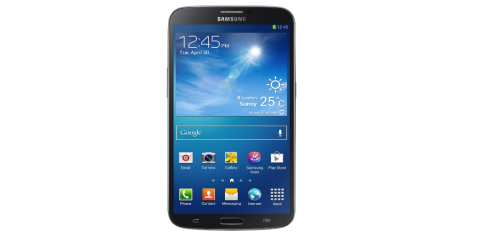

The FonePad feels like the biggest phone we’ve ever tested (including the ‘bricks’ of years ago. A 7-inch screen gives the FonePad the largest display on any phone, and it’s NOT a tablet. Asus is selling it as a super-sized phone.
[alert type=alert-blue]DESIGN[/alert]
Asus builds the Google Nexus 7. The FonePad has similar design cues as well as being the same size as the Nexus. It’s not a pretty phone, compared with Lumias and iPhones, which isn’t helped by huge two-inch wide bezel top and bottom. A plain black front contains a speaker and front-facing camera at the top and a plain metallic back with just an Asus logo to break up the expanse of black. It weighs a rather hefty 340g and measures 196x120x10mm, so is not particularly pocket friendly.
Forget about one-handed operation. It just about fits in one hand.
You won’t want to hold it next to your ear either. It just feels awkward and embarrassing in public. The side reveals minimalist design with just three buttons on the entire device . These are volume up and down buttons as well as a power button and a 3.5mm headphone jack and micro USB port. The SIM card tray and micro SD card slot are well hidden under a dark grey rubber grommet. You can’t quite remove the huge 4,270mAh battery but you can insert a micro SIM or micro SD card.
[alert type=alert-blue]FEATURES AND DISPLAY[/alert]
The Asus FonePad is a basic phone. There’s no 4G LTE connectivity. Nor is there a dual or even quad-core processor. It is powered by a single-core Intel processor clocked at 1.2GHz and 1GB of RAM.
The rather low resolution screen is 1,280×800 pixels. The 216ppi does pull it ahead of the iPad Mini though. The screen’s outdoor mode helps in bright conditions. But not as well as on some other phones and tablets. The brightness is rather dull.
Asus‘s ‘Splendid’ app changes the screen colour temperature from warm colours to cooler colours. Anything other than the default setting made the colours look artificial. Viewing angles are top-notch and we were still able to see detail even viewing from the side.
[alert type=alert-blue]PERFORMANCE[/alert]
While its spec sheet seems basic the device just about managed some 3D gaming. If you want to play a game like N.O.V.A then you may encounter a few glitches, such as frames dropping out. But when we tried smash-hit Candy Crush we had no such problem, and it ran smoothly.
Android 4.1 Jelly Bean is the default operating system which is two versions behind the current version of Android. This is not a big deal. You’ll find most of the features you need. Asus has added some tweaks to standard Android such as the ‘Splendid’ app and a few extra widgets, like the weather widget, but not much else. There is no back camera. The 1.2-megapixel front-facing camera is fine for Skype video calling but not much else.
The 4,270mAh battery ensured that the device could run the 7-inch display with ease and it even powered the phone for several days. If great battery life on an Android device is important to you, look no further.
[alert type=alert-blue]CONCLUSION[/alert]
The FonePad feels more like a tablet than a phone. You can make phone calls, but you’re more likely to use its 3G connection to browse the internet when there is no wi-fi available. The omission of a rear camera is curious given the almost universal inclusion on both tablets and phones. But this product is unlikely to replace your phone, so you’ll probably have ready access to a camera anyway.
The most impressive factoid is the £180 price tag which makes this an incredibly affordable tablet. As a backup phone/tablet the FonePad makes perfect sense.





